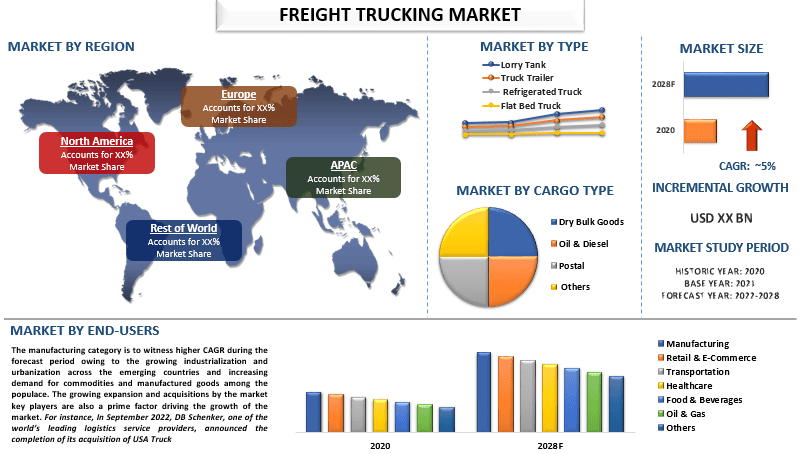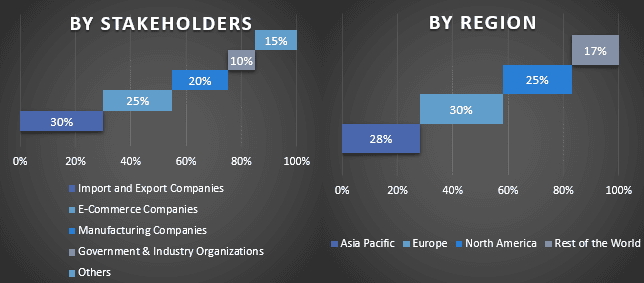Рынок грузовых автомобильных перевозок: текущий анализ и прогноз (2022-2028 гг.)
Акцент на типе (автоцистерна, грузовой прицеп, рефрижератор и бортовой грузовик); Тип груза (насыпные грузы, нефть, дизельное топливо, почтовые отправления и прочее); Конечные пользователи (производство, розничная торговля и электронная коммерция, транспорт, здравоохранение, продукты питания и напитки, нефтегазовая отрасль и прочее)); и регион/страна

ЗАПРОСИТЬ БЕСПЛАТНЫЙ ОБРАЗЕЦ PDF
Ожидается, что глобальный рынок грузовых автомобильных перевозок будет расти значительными темпами, примерно на 5%, в течение прогнозируемого периода. Тяжелый автомобиль, обычно называемый грузовым автомобилем, используется для перевозки товаров из одного места в другое. Он имеет множество применений в логистике и отлично подходит для езды по бездорожью. Грузовые автомобили с легкостью могут перевозить большие грузы, поскольку они профессионально спроектированы и управляются. Грузовики с грузовыми двигателями, которые являются очень современными и мощными, могут легко транспортировать сыпучие материалы. Растущий бизнес в сфере электронной коммерции, обеспечение безопасности и сохранности товаров, внедрение новых технологий для отслеживания товаров являются факторами, стимулирующими рост рынка. Например, ECU360 запустила решение для внутренних перевозок, чтобы связать грузоотправителей с перевозчиками по всей территории Соединенных Штатов. Решение построено в партнерстве с ECU Trucking и запущено на платформе ECU360 для оптимизации и автоматизации громоздкого процесса поиска перевозчиков или грузоотправителей, возможности отслеживать доставку от начала до конца и получать расценки на перевозку грузов.
Canadian National Railway Company, A.P. Moller – Maersk, CEVA Logistics, CMA CGM Group, DHL Paket GmbH, Deutsche Post AG, Estes Express Lines, FedEx, NIPPON EXPRESS HOLDINGS и United Parcel Service of America, Inc. являются одними из ключевых игроков на рынке. Этими игроками было предпринято несколько слияний и поглощений, а также партнерств, чтобы предоставить клиентам высокотехнологичные и инновационные продукты/технологии.
Аналитические выводы, представленные в отчете
«Ожидается, что среди типов грузов категория нефти и дизельного топлива будет демонстрировать более высокий среднегодовой темп роста в течение прогнозируемого периода»
На основе типа груза рынок подразделяется на сухие сыпучие грузы, нефть и дизельное топливо, почтовые отправления и другие. Среди них ожидается, что категория нефти и дизельного топлива будет иметь более высокий среднегодовой темп роста в течение прогнозируемого периода из-за расширения обрабатывающей промышленности и увеличения спроса на безопасную и эффективную транспортировку горючих жидкостей, таких как нефть и дизельное топливо.
«Ожидается, что среди конечных пользователей обрабатывающая промышленность будет демонстрировать более высокий среднегодовой темп роста в течение прогнозируемого периода.
На основе конечных пользователей рынок был классифицирован на обрабатывающую промышленность, розничную торговлю и электронную коммерцию, транспорт, здравоохранение, продукты питания и напитки, нефть и газ и другие. Ожидается, что категория обрабатывающей промышленности будет демонстрировать более высокий среднегодовой темп роста в течение прогнозируемого периода из-за растущей индустриализации и урбанизации в развивающихся странах и увеличения спроса на товары и промышленные товары среди населения. Растущая экспансия и приобретения ключевыми игроками рынка также являются основным фактором, стимулирующим рост рынка. Например, в сентябре 2022 года DB Schenker, один из ведущих мировых поставщиков логистических услуг, объявила о завершении приобретения USA Truck.
«Ожидается, что Азиатско-Тихоокеанский регион будет расти значительными темпами среднегодового роста в течение прогнозируемого периода»
Для лучшего понимания принятия рынком индустрии вездеходных транспортных средств рынок анализируется на основе его всемирного присутствия в таких странах, как Северная Америка (США, Канада, остальная часть Северной Америки), Европа (Германия, Великобритания, Франция, Испания, Италия, остальная часть Европы), Азиатско-Тихоокеанский регион (Китай, Япония, Индия, остальная часть Азиатско-Тихоокеанского региона), остальной мир. Ожидается, что Азиатско-Тихоокеанский регион будет расти значительными темпами среднегодового роста в течение прогнозируемого периода из-за растущего уровня индустриализации в развивающихся странах Азиатско-Тихоокеанского региона, особенно в Китае, Индии, Южной Корее и Японии. Рост рынка в регионе поддерживается ростом импортной и экспортной деятельности в этих растущих экономиках. Ожидается, что растущая урбанизация и повышение уровня жизни в Азии и Тихоокеанском регионе окажут влияние на расширение услуг по доставке от двери до двери. Кроме того, одним из ключевых факторов, которые, как ожидается, будут способствовать расширению рынка в течение прогнозируемого периода, является увеличение спроса на услуги онлайн-торговли.
Причины покупать этот отчет:
- Исследование включает в себя анализ размера рынка и прогнозирования, подтвержденный аутентифицированными ключевыми экспертами отрасли.
- Отчет представляет собой краткий обзор общих показателей отрасли с первого взгляда.
- Отчет охватывает углубленный анализ видных представителей отрасли с упором на ключевые финансовые показатели бизнеса, портфель продуктов, стратегии расширения и последние разработки.
- Подробное изучение драйверов, ограничений, ключевых тенденций и возможностей, преобладающих в отрасли.
- Исследование всесторонне охватывает рынок по различным сегментам.
- Углубленный анализ отрасли на региональном уровне.
Варианты настройки:
Глобальный рынок грузовых автомобильных перевозок может быть дополнительно настроен в соответствии с требованиями или любым другим сегментом рынка. Кроме того, UMI понимает, что у вас могут быть свои собственные бизнес-потребности, поэтому не стесняйтесь обращаться к нам, чтобы получить отчет, который полностью соответствует вашим требованиям.
Содержание
Методология исследования анализа рынка грузовых автомобильных перевозок (2022-2028 гг.)
Анализ исторического рынка, оценка текущего рынка и прогнозирование будущего рынка глобального рынка грузовых автомобильных перевозок были тремя основными шагами, предпринятыми для создания и анализа внедрения грузовых автомобильных перевозок в основных регионах мира. Было проведено исчерпывающее вторичное исследование для сбора исторических рыночных данных и оценки текущего размера рынка. Во-вторых, для подтверждения этих выводов было принято во внимание множество результатов и предположений. Более того, были проведены исчерпывающие первичные интервью с отраслевыми экспертами по всей цепочке создания стоимости глобального рынка грузовых автомобильных перевозок. После предположений и подтверждения рыночных данных посредством первичных интервью мы использовали восходящий/нисходящий подход к прогнозированию полного размера рынка. После этого были приняты методы декомпозиции рынка и триангуляции данных для оценки и анализа размера рынка сегментов и подсегментов, к которым относится отрасль. Подробная методология объяснена ниже:
ЗАПРОСИТЬ БЕСПЛАТНЫЙ ОБРАЗЕЦ PDF
Анализ исторического размера рынка
Шаг 1: Углубленное изучение вторичных источников:
Было проведено детальное вторичное исследование для получения исторических данных о размере рынка грузовых автомобильных перевозок из внутренних источников компании, таких как годовые отчеты и финансовая отчетность, презентации результатов деятельности, пресс-релизы и т. д., и внешних источников, включая журналы, новости и статьи, правительственные публикации, публикации конкурентов, отраслевые отчеты, сторонние базы данных и другие надежные публикации.
Шаг 2: Сегментация рынка:
После получения исторических данных о размере рынка грузовых автомобильных перевозок мы провели детальный вторичный анализ для сбора исторических данных о рынке и доли различных сегментов и подсегментов для основных регионов. Основные сегменты, включенные в отчет, включают тип, тип груза и конечных пользователей. Был проведен дальнейший анализ на уровне стран для оценки общего внедрения моделей тестирования в этом регионе.
Шаг 3: Факторный анализ:
После получения исторических данных о размере рынка различных сегментов и подсегментов мы провели детальный факторный анализ для оценки текущего размера рынка грузовых автомобильных перевозок. Кроме того, мы провели факторный анализ с использованием зависимых и независимых переменных, таких как различные типы, типы грузов и конечные пользователи грузовых автомобильных перевозок. Был проведен тщательный анализ сценариев спроса и предложения с учетом ведущих партнерств, слияний и поглощений, расширения бизнеса и запуска продуктов в секторе рынка грузовых автомобильных перевозок по всему миру.
Оценка и прогноз текущего размера рынка
Определение текущего размера рынка: На основе практически применимых выводов, полученных из вышеуказанных 3 шагов, мы пришли к текущему размеру рынка, ключевым игрокам на глобальном рынке грузовых автомобильных перевозок и долям рынка сегментов. Все необходимые процентные доли разделения и разбивки рынка были определены с использованием вышеупомянутого вторичного подхода и проверены посредством первичных интервью.
Оценка и прогнозирование: Для оценки и прогнозирования рынка веса были присвоены различным факторам, включая движущие силы и тенденции, ограничения и возможности, доступные для заинтересованных сторон. После анализа этих факторов были применены соответствующие методы прогнозирования, т. е. восходящий/нисходящий подход, чтобы получить прогноз рынка на 2028 год для различных сегментов и подсегментов на основных рынках по всему миру. Методология исследования, принятая для оценки размера рынка, включает в себя:
- Размер рынка отрасли с точки зрения выручки (доллары США) и темпы внедрения рынка грузовых автомобильных перевозок на основных рынках внутри страны
- Все процентные доли, разделения и разбивки рыночных сегментов и подсегментов
- Ключевые игроки на глобальном рынке грузовых автомобильных перевозок с точки зрения предлагаемых продуктов. Кроме того, стратегии роста, принятые этими игроками для конкуренции на быстрорастущем рынке
Проверка размера рынка и доли рынка
Первичное исследование: Были проведены углубленные интервью с ключевыми лидерами мнений (KOL), включая руководителей высшего звена (CXO/вице-президенты, руководители отдела продаж, руководители отдела маркетинга, руководители операционного отдела, региональные руководители, главы стран и т. д.) в основных регионах. Затем результаты первичного исследования были обобщены, и был проведен статистический анализ для доказательства заявленной гипотезы. Входные данные первичных исследований были объединены с результатами вторичных исследований, что превратило информацию в действенные выводы.
Распределение основных участников в разных регионах

Инжиниринг рынка
Метод триангуляции данных был использован для завершения общей оценки рынка и получения точных статистических данных для каждого сегмента и подсегмента глобального рынка грузовых автомобильных перевозок. Данные были разделены на несколько сегментов и подсегментов после изучения различных параметров и тенденций в областях типа, типа груза и конечных пользователей на глобальном рынке грузовых автомобильных перевозок.
Запросить индивидуальную настройку
Основная цель исследования глобального рынка грузовых автомобильных перевозок
В исследовании были точно определены текущие и будущие рыночные тенденции глобального рынка грузовых автомобильных перевозок. Инвесторы могут получить стратегическую информацию, чтобы основывать свое усмотрение для инвестиций на качественном и количественном анализе, выполненном в исследовании. Текущие и будущие рыночные тенденции определили общую привлекательность рынка на региональном уровне, предоставив промышленному участнику платформу для использования неиспользованного рынка для получения выгоды от преимущества первопроходца. Другие количественные цели исследований включают:
- Проанализировать текущий и прогнозируемый размер рынка грузовых автомобильных перевозок с точки зрения стоимости (доллары США). Кроме того, проанализировать текущий и прогнозируемый размер рынка различных сегментов и подсегментов
- Сегменты в исследовании включают области типа, типа груза и конечных пользователей.
- Определение и анализ нормативно-правовой базы для грузовых автомобильных перевозок
- Проанализировать цепочку создания стоимости, связанную с присутствием различных посредников, а также проанализировать поведение клиентов и конкурентов отрасли.
- Проанализировать текущий и прогнозируемый размер рынка грузовых автомобильных перевозок для основного региона.
- Основные страны регионов, изученные в отчете, включают Азиатско-Тихоокеанский регион, Европу, Северную Америку и остальной мир.
- Профили компаний рынка грузовых автомобильных перевозок и стратегии роста, принятые участниками рынка для поддержания позиций на быстрорастущем рынке
- Углубленный анализ отрасли на региональном уровне
Связанные Отчеты
Клиенты, купившие этот товар, также купили










